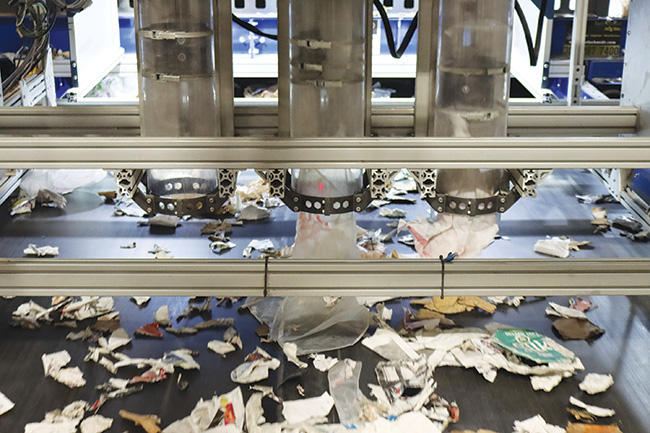The expanding identification capabilities of AI systems paired with sorting mechanisms specific to recycling operations will help address the plastic waste crisis and divert millions of tons of recoverable material from landfills annually.
By Josh Hollin
Today, a mere 2 percent of U.S. households have curbside access for recycling film and flexible packaging, estimates The Recycling Partnership. Yet film and flexibles comprise the fast-growing and second-largest valued packaging segment, behind only corrugated containers and ahead of bottles and other rigid plastic packaging. Close to 98 pounds of these materials, including grocery and storage bags, pouches, and wrappers, are found in the average U.S. home each year.

Complicated Removal and Recovery
Compounding the challenges presented by the proliferation of these materials, the recycling industry has lacked infrastructure to identify and separate film. Recovery within the existing materials recovery facility (MRF) infrastructure is estimated at 3 percent, meaning the vast majority of residential film and flexible packaging ends up in landfills. Moreover, these materials jam or gum up the equipment in recycling facilities that are not designed to handle them. It is rare to see a MRF that does not have a challenge or headache dealing with film somewhere in the system; more typically, it is in multiple places in the system. Even 2 to 3 percent film in overall MRF streams can be unmanageable to remove manually, often damaging equipment, necessitating downtime, and hindering recovery of recyclables.
Film contamination also exacerbates the industry’s labor strain because it requires manual sorters or dedicated technology to remove it early in the sorting process. Because of its light weight, film finds its way onto nearly every line in a recycling facility, degrading bale purity and leading to revenue loss or the need for additional downstream processing.
Enhanced Material Identification
AI-powered recycling has scaled quickly. Using computer vision, machine learning, and robots to identify and sort recyclable materials, the accuracy of automated sorting machines has improved, reducing the need for human intervention and boosting overall
recovery rates. Robots powered by AI may have been somewhat of a novelty in 2017, but today the industry sees them as a critical investment worth expanding or even redesigning their MRFs to accommodate, experts say. And now, we are seeing AI enable new types of sorting devices for the recycling industry—those that are uniquely suited to reduce the contamination burden on recycling facilities and scale the recycling of film and flexible packaging.
AI provides the means for reliable and consistent identification of films in complex material streams. The AI is trained to distinguish film in a variety of colors, shapes, sizes, and in a range of conditions—ripped or torn, partially obscured, wet, or contaminated. When the capabilities of AI are combined with recycling-specific hardware, you can produce an automation solution that can remove significant volumes of film quickly, with little change to the existing material stream.

Growing End Markets
Because these materials are complicated and expensive to reprocess into raw materials, end markets for film and flexible packaging have been limited. While flexible packaging has been almost uniformly single-use, major brands continue to make commitments to use more recycled content in their products, and several states have recently adopted laws aimed at ramping up the use of post-consumer resin in plastic products and packaging. AI is addressing how to recover film economically, which will help boost recovery and demand for products manufactured from recycled films to catalyze and support end markets.
Many MRFs are looking for a solution for film contamination immediately, even if it is simply removing the film to residue for the benefit of keeping it out of screens, fiber bales, and other equipment. With the ability to capture film in use, even if it goes to residue
initially, demand will be easier to catalyze since it is no longer a question of how to remove it economically, but only whether end-market demand is sufficient to make storage and shipment worthwhile for a given MRF.
Bridging the Gap
The waste and recycling industry needs infrastructure beyond what exists today to meet brands’ post-consumer recycled content and other sustainability commitments and demands from the regulatory environment. More states will pass laws raising diversion goals and
establishing extended producer responsibility programs. The expanding identification capabilities of AI systems paired with sorting mechanisms specific to recycling operations will help bridge this infrastructure gap, while addressing the plastic waste crisis and diverting millions of tons of recoverable material from landfills annually. | WA
Josh Hollin is VP of Engineering for AMP Robotics. With nearly 30 years of operations, engineering and technology experience, he most recently served as Vice President of Engineering and Global Product Launch Teams at Flex, a leader in technology innovation, supply chain, and manufacturing solutions. He previously held operations and program management leadership roles at Flex, in addition to Garmin International and Nortek, Inc. He can be reached at [email protected].
Reference
www.wastedive.com/news/national-sword-five-years-mrf-robotics-recycling-investment/630731/
